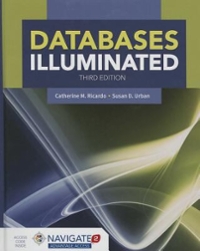8) One of the limitations of the model is that there is a lack of standards. A. Hierarchical B. Network. C. Relational D. Entity Relationship 9) The CUSTOMER table's primary key is CUS CODE. The CUSTOMER primary key column has no null entries, and all entries are unique. This is an example of interrity. A. Entity B. Referential C. Relatiomal D. Nuli 10) In a database context, the word indicates the use of the same attribute name to label different attributes. A. Redundancy B. Homonym C. Duplicate D. Synonym 11) A(n) is an orderly arrangement used to logically access rows in a table. A. Primary rule B. Superkey C. Relationship D. Index 12) A(n) only returns matehed records from the tubles that are being joined. A. outer join B. inner join C. equijoin D. theta join 13) The entity relationship diagram (ERD) represents the database as viewed by the end user. A. Condensed B. Physical C. Logical D. Conceptual 14) The decision to store attributes in database tables depends on the processing requirements and the constraints placed on a particular application. A. Multivalued B. Derived C. Single-valued D. Composite 15) A entity has a primary key that is partially or totally derived from the parent entity in the relationship. A. Strong B. Weak C. Business D. Child 16) If Tiny College has some departments that are classified as "research only" and do not offer courses, the COURSE entity of the college database would be the DEPARTMENT entify. A. existence-dependent on B. independent of C. mandatory for D. Optional to 17) Which of the following is a specialization hierarchy disjoint constraint scenario in case of partial completeness? A. Subtype discriminator can be null. B. Subtype discriminator cannot be null. C. Each supertype occurrence is a member of only one subtype. D. Each supertype occurrence is a member of at least one subtype. 18) According to the "preferably single-attribute" characteristic of a primary key, the primary key: A. must be able to guarantee unique attribute values. B. Should have the minimum number of attributes possible. C. Should have embedded semantic meaning associated with each attribute. D Must be composed of attributes that are free from security risks or violations. 19) When selecting a foreign key placement for a 1 : I relationship, place the PK of the entity on the mandatory side in the entity on the optional side as a FK. and make the FK mandatory when A. One side is mandatory and the other side is optional B. One side participates in another relationship C. Both sides are optional D. Both sides are mandatory







